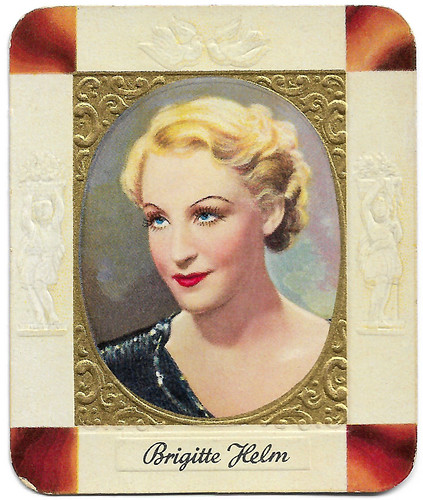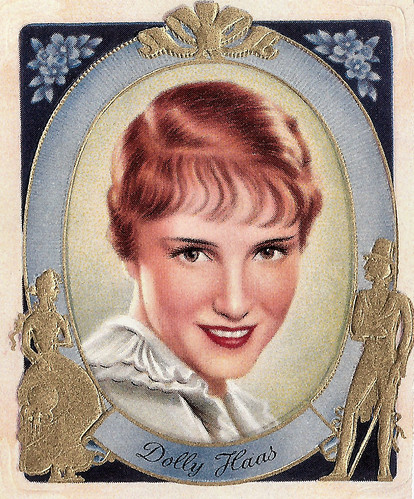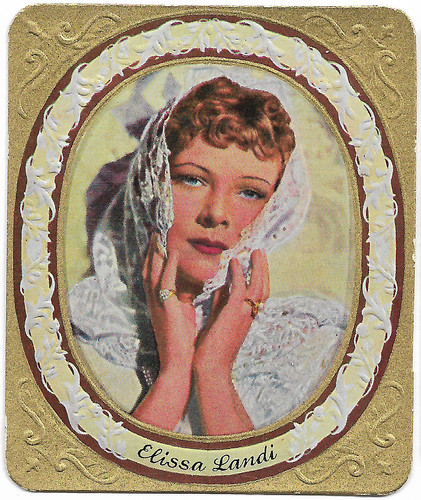
German collector card in the Moderne Schönheitsgalerie Series by Ross Verlag, no 6 (of 300). Photo: Ufa. The card was a supplement to 'Edelzigarette' Kurmark of the Garbaty Cigarette Company.
German actress Brigitte Helm (1908-1996) is still famous for her dual role as Maria and her double the evil Maria, the Maschinenmensch, in the silent SF classic Metropolis (Fritz Lang, 1927). After Metropolis she made a string of over 30 films in which she almost always had the starring role. She easily made the transition to sound films, before she abruptly retired in 1935.

German collectors card in the Moderne Schönheitsgalerie by Ross Verlag for 'Edelzigarette' Kurmark of the Garbaty Cigarette Company, no. 55. Photo: Hisa-Film.
German-born, British stage and screen actress Dolly Haas (1910-1994) was popular in the 1930s as a vivacious, red-haired 'gamine' often wearing trousers in German and British films. Although she got a 3-year contract with Columbia and worked in Hollywood with Alfred Hitchcock, Dolly's American career mainly took place on and Off-Broadway.

German collector card in the Moderne Schönheitsgalerie by Ross Verlag for 'Edelzigarette' Kurmark of the Garbaty Cigarette Company, no. 56. Photo: Dolly Haas in Warum lügt Fräulein Käthe?/Why is Miss Käthe lying? (Georg Jacoby, 1935).
The Jewish Garbaty Family
In the 1930s, the Nazi regime in Germany was not happy with Hollywood. One of the reasons was the Jewish background of many of the Hollywood studio moguls, another reason was the themes of the films.
However, American movies, and their stars, were quite popular with German audiences, and it wasn't until late in the decade that Hollywood studio product was heavily suppressed.
The Garbaty family, which had owned their cigarette firm for nearly half a century, was Jewish. In late 1938, the Nazis staged Kristallnacht, where several hundred Jews were murdered and their property seized.
Owner Moritz Garbaty hid out at the home of his Catholic secretary, and his wife and 8-year-old son Thomas were visited by the Gestapo, which was seeking his father.
Several days later, Moritz was reunited with his family. He sold the company for a fraction of its worth and left for America, securing the family's safety with a million-dollar bribe to authorities. The family survived in the USA.

German collector card in the Moderne Schönheitsgalerie series by Ross Verlag for 'Edelzigarette' Kurmark of the Garbaty Cigarette Company, no. 142. Photo: Paramount.
Ida Lupino (1918-1995) was an English-American actress and singer, who became a pioneering director and producer — the only woman working within the 1950s Hollywood studio system to do so.

German collector card in the Moderne Schönheitsgalerie series, no. 149 (out of 300). The series was produced by Ross Verlag for the Garbaty Cigarette Company as a supplement for their 'Edelzigarette' Kurmark. Photo: Metro Goldwyn Mayer (M.G.M.). Myrna Loy in The Mask of Fu Manchu (Charles Brabin, 1932).
Myrna Loy (1905-1993) was an American film, television, and stage actress. She was originally typecast in exotic roles, often as a vamp or a woman of Asian descent, but her career prospects improved greatly following her portrayal of Nora Charles in The Thin Man (W.S. Van Dyke, 1934). Suddenly she was the 'Queen of the Movies' and remained so until the late 1940s.

German collector card in the Moderne Schönheitsgalerie by Ross Verlag for the Garbaty Cigarette Company as a supplement for their 'Edelzigarette' Kurmark, no. 151 of 300. Photo: Fox.
Joan Bennett (1910–1990) was an American actress who had her breakthrough in Little Women (George Cukor, 1933). Producer Walter Wanger helped to manage her career and eventually married her in 1940. At the beginning of the 1940s, Bennett appeared in four films by Fritz Lang. These turned her into a femme fatale of the Film Noir.

German collector card in the Moderne Schönheitsgalerie by Ross Verlag for the Garbaty Cigarette Company as a supplement for their 'Edelzigarette' Kurmark, no. 167 of 300. Collection: Marlène Pilaete.
In the second half of the 1930s and the first half of the 1940s, Alice Faye (1915-1998) was a name to reckon with in the world of Hollywood musicals. Her compelling voice, her remarkable ability to put over a song and her endearing screen persona made her a top star. In the U.S. Quigley’s Motion Picture Exhibitors’ Poll, which was the barometer of the stars’ box-office power, she placed 9th in 1938, 7th in 1939, 13th in 1940, 12th in 1941 and 1943 and 15th in 1944 (in 1942, she had been away from the screen).

German cigarette card by Ross Verlag in the 'Moderne Schönheitsgalerie' series for the Garbaty Cigarette Company as a supplement for their 'Edelzigarette' Kurmark, no. 289. Photo: Metro-Goldwyn-Mayer (MGM).
American actress Norma Shearer (1902-1983) was the 'First Lady of MGM'. She often played spunky, sexually liberated ingenues, and was the first person to be nominated five times for an Academy Award for acting. Shearer won the Best Actress Oscar for The Divorcee (1930).

German collector card in the 'Moderne Schönheitsgalerie' by Ross Verlag for the Garbaty Cigarette Company as a supplement for their 'Edelzigarette' Kurmark, no 292 (of 300). Photo: Paramount.
Austrian-born actress and writer Elissa Landi (1904–1948) was (falsely) rumoured to be a descendant of Emperor Franz Joseph of Austria. During the 1920s, she appeared in British, French, and German films before travelling to the United States. In Hollywood, she became a popular star of the 1930s.

German collector card in the 'Moderne Schönheitsgalerie' by Ross Verlag for the Garbaty Cigarette Company as a supplement for their 'Edelzigarette' Kurmark, second series, no. 64 (of 300). Photo: Metro-Goldwyn-Mayer.
American film actress Jean Harlow (1911–1937) was with her come-hither body, platinum blonde hair, and keen sense of humour, one of Hollywood's sex symbols of the 1930s. She had her breakthrough in Howard Hughes' World War I epic Hell's Angels (1930). Frank Capra's Platinum Blonde (1931) cemented her role as America's new sex symbol. In 1932, she signed with Metro-Goldwyn-Mayer and became the leading lady in a string of hit films. These included Red Dust (1932), Dinner at Eight (1933), Reckless (1935) and Suzy (1936). Among her frequent co-stars were William Powell, Spencer Tracy and, in six films, Clark Gable.

German collector card in the Moderne Schönheitsgalerie by Ross Verlag for the Garbaty Cigarette Company as a supplement for their 'Edelzigarette' Kurmark, series 2, no. 188. Fritz Rasp and Hilde von Stolz in Lockspitzel Asew/Decoy Asew (Phil Jutzi, 1935).
German film actor Fritz Rasp (1891–1976) appeared in 104 films between 1916 and 1976. He excelled in dark roles: villains, rapists, traitors. His most notable film parts were Der Schmale (The Thin Man) in Fritz Lang's Metropolis (1927), Meinert in Tagebuch einer Verlorenen/Diary of a Lost Girl (1929), and J. J. Peachum in Die 3-Groschen-Oper/The Threepenny Opera (1931). Hilde von Stolz (1903-1973) was a blonde Austrian leading lady and supporting actress in Ufa films of the 1930s and 1940s.

German collector card in the 'Moderne Schönheitsgalerie' by Ross Verlag for the Garbaty Cigarette Company as a supplement for their 'Edelzigarette' Kurmark, series 2, no. 255 of 300. Photo: Europa.
Trude Marlen (1912-2005), was a curly-locked Austrian leading lady of the 1930s. From 1933 until the 1940s, she made mostly light entertainment films as a Ufa star. Willi Forst was often her partner. The Ufa traded her as the German answer to Jean Harlow, but for the most part, she was rather the Viennese equivalent of the 'girl next door', engaging and uncomplicated.

German collector card in the 'Moderne Schönheitsgalerie' by Ross Verlag for the Garbaty Cigarette Company as a supplement for their 'Edelzigarette' Kurmark, series 2, no. 257, issued by Kur Mark Cigarettes. Photo: Lloyd - Rota. Peter Voss in Mein Leben für Maria Isabell/My Life for Maria Isabella (Erich Waschneck, 1935).
Peter Voss (1891-1979) was a German character actor and occasional leading man. Following military service in World War I, he first appeared on stage. He was often seen as bon vivants, titled landowners or sea captains. Voss never quite established himself as a major star.

German collector card in the Moderne Schönheitsgalerie by Ross Verlag for the Garbaty Cigarette Company as a supplement for their 'Edelzigarette' Kurmark, series 2, no. 267 of 300. Photo: Paramount. Kay Francis as Carmen in the episode 'The Toreador' in Paramount on Parade (Edmund Goulding a.o., 1930).
American stage and film actress Kay Francis (1905-1968) was a tall, attractive, grey-eyed brunette with undeniable style and poise, known for films such as Ernst Lubitsch's Trouble in Paradise (1932). For a while, in the 1930s she ranked as one of America's most popular actresses, tagged the 'Queen of Warner Brothers'.

German collector card in the 'Galerie Schöner Frauen Des Films' (Gallery of Beautiful Women in Film) in 1936 by Ross Verlag for the Garbaty Cigarette Company as a supplement for their 'Edelzigarette' Kurmark, series 2, no. 47 (of 300). Photo: Metro-Goldwyn-Mayer. Greta Garbo and John Gilbert in Queen Christina (Rouben Mamoulian, 1933).
Swedish-born Greta Garbo (1905-1990) was one of the greatest and most glamorous film stars ever produced by the Hollywood studio system. She was part of the Golden Age of the silent cinema of the 1920s but Garbo was one of the few Hollywood actors who made a glorious transition to the talkies.
American actor, screenwriter, and director John Gilbert (1899-1936) rose to fame during the silent film era and became a popular leading man known as 'The Great Lover'. With Great Garbo, he began a highly publicised, torrid off-screen affair. The studio publicity department worked overtime to publicise the romance between the two. His career did not survive the arrival of sound film.
Sources: Virtual History, Carole & Co, and Garbo Forever.
Our Ross Verlag Tribute will be continued in 2025. In the meantime, please check out the Ross Verlag Movie Stars Postcards website.
No comments:
Post a Comment